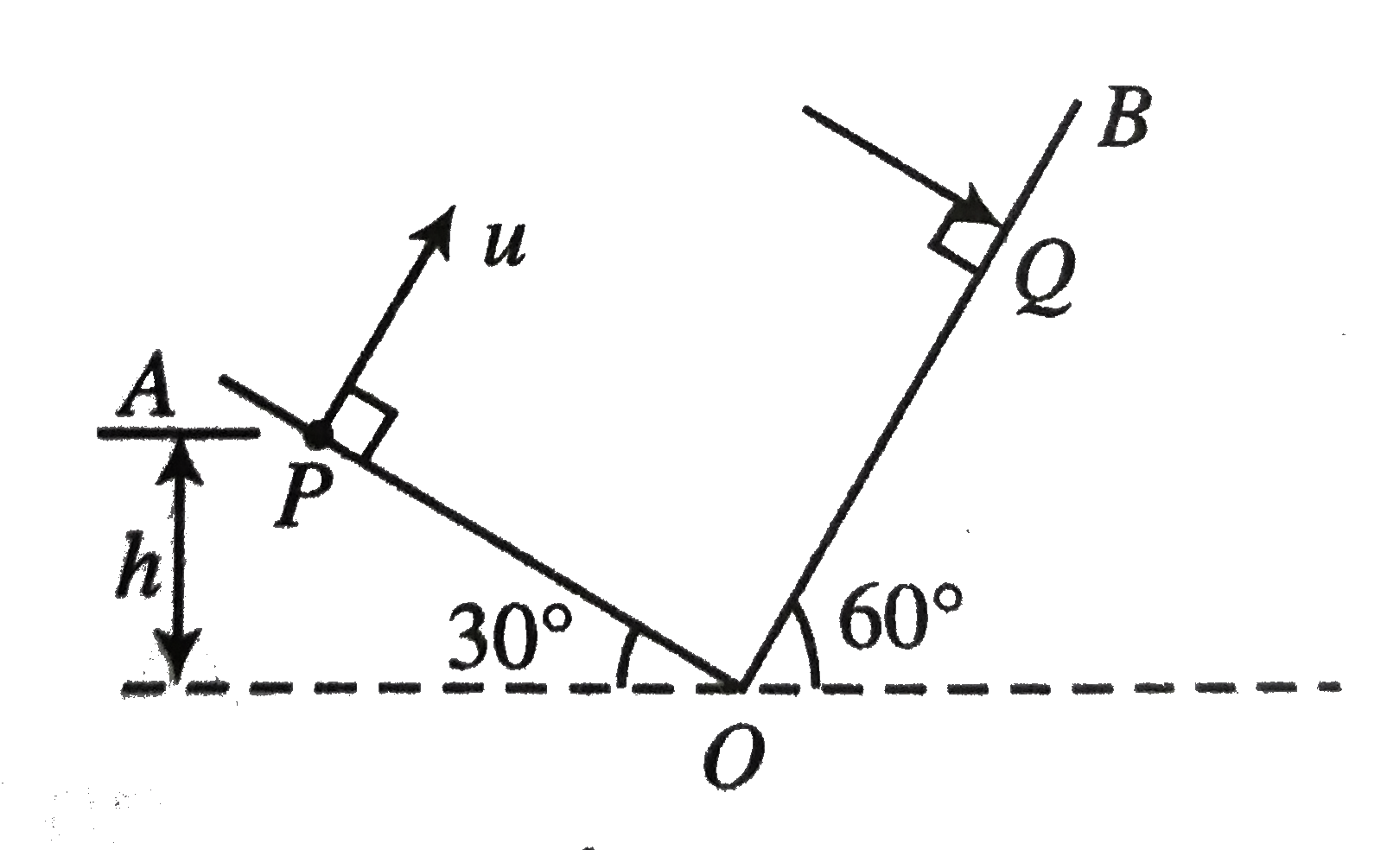Two inclined planes OA and OB having inclinations 30∘ and 60∘ with the horizontal respectively intersect each other at O, as shown in figure. A particle is projected from point P with velocity u=10√3m/s along a direction perpendicular to plane OA. If the particle strikes plane OB perpendicular at Q. Calculate.

(a) time of flight,
(b) velocity with which the particle strikes the plane OB,
(c) height h of point P from point O,
(d) distance PQ. (Take g=10m/s2)
The correct Answer is:B
Let us choose the x and y directions along OB and OA respectively. Then,
ux=u=10(√3)m/s,uy=0
ax=−gsin60∘=−5(√3)m/s2
and ay=−gcos60∘=−5m/s2
(a) At point Q, x-component of velocity is zero. Hence, substituting in
vx=ux+axt
0=10√3−5(√3)t
or t=10√35√3=2s
(b) At point Q, v=vy=uy+ayt
∴v=0−(5)(2)=−10m/s
Here, negative sign implies that velocity of particles at Q is along negative y-direction.
(c) Distance PO=∣ displacement of particle along y-direction|=|sy∣∣
Here, sy=uyt+12ayt2
=0−12(5)(2)2=−10m
∴PO=10m
Therefore, h=POsin30∘=(10)(12)
or h=5m.
(d) Distance OQ = displacement of particle along x-direction = sx
Here, sx=uxt+12axt2
=(10√3)(2)−12(5√3)(2)2=10√3m
or OQ=10√3m
∴PQ=√PO2+(OQ)2
=√102+(10√3)2
=√100+300=√400
∴PQ=20m.
Topper's Solved these Questions
- PROJECTILE MOTIONBOOK - DC PANDEYCHAPTER - PROJECTILE MOTIONEXERCISE - Exercise 7.1
5 Videos
- PROJECTILE MOTIONBOOK - DC PANDEYCHAPTER - PROJECTILE MOTIONEXERCISE - Exercise 7.2
10 Videos
- PROJECTILE MOTIONBOOK - DC PANDEYCHAPTER - PROJECTILE MOTIONEXERCISE - Example Type 5
3 Videos
- MOTION IN A PLANEBOOK - DC PANDEYCHAPTER - MOTION IN A PLANEEXERCISE - (C )Medical entrances gallery
32 Videos
- PROPERTIES OF MATTERBOOK - DC PANDEYCHAPTER - PROPERTIES OF MATTEREXERCISE - Integer
8 Videos
Similar Questions
Two inclined planes OA and OB having inclination (with horizontal) 30∘ and 60∘, respectively, intersect each other at O as shown in figure. A particle is projected from point P with velocity u=10(√3)ms−1 along a direction perpendicular to plane OA. If the particle strikes plane OB perpendicularly at Q, calculate

The velocity with which particle strikes the plane OB,
View SolutionTwo inclined planes OA and OB having inclination (with horizontal) 30∘ and 60∘ respectively , intersect each other at O. A particle is projected from point 'P' with velocity u=10√3 m/s along a direction perpendicu lar to plane OA. If the particle strikes plane OB perpendicu lar at Q. Calcu late:

Time of flight of the particle:
View Solution
Knowledge Check
Two inclined planes OA and OB having inclination (with horizontal) 30∘ and 60∘, respectively, intersect each other at O as shown in figure. A particle is projected from point P with velocity u=10(√3)ms−1 along a direction perpendicular to plane OA. If the particle strikes plane OB perpendicularly at Q, calculate

The distance PQ,A20 mB10 mC5 mD2.5 mTwo inclined planes OA and OB having inclination (with horizontal) 30∘ and 60∘, respectively, intersect each other at O as shown in figure. A particle is projected from point P with velocity u=10(√3)ms−1 along a direction perpendicular to plane OA. If the particle strikes plane OB perpendicularly at Q, calculate

Time of flight of the particlesA8 sB6 sC4 sD2 sTwo inclined planes OA and OB having inclination (with horizontal) 30∘and60∘, respectively, intersect each other at O as shown in figure. A particle is projected from point P with velocity u=10√3ms−1 along a direction perpendicular to plane OA. If the particle strikes plane OB perpendicularly at Q, calculate

The vertical height h of P from O,A10 mB5 mC15 mD20 m
Two inclined planes OA and OB having inclination (with horizontal) 30∘ and 60∘(), respectively, intersect each other at O as shown in figure. A particle is projected from point P with velocity u=10√3ms−1 along a direction perpendicular to plane OA. If the particle strikes plane OB perpendicularly at Q, calculate

The maximum height attained by the particle (from the line O)
View SolutionTwo inclined planes OA and OB having inclination (with horizontal) 30∘ and 60∘ respectively , intersect each other at O. A particle is projected from point 'P' with velocity u=10√3 m/s along a direction perpendicu lar to plane OA. If the particle strikes plane OB perpendicu lar at Q. Calcu late:

The velocity with which particle strikes the plane OB.
View SolutionTwo inclined planes (I) and (II) have inclination alpha and beta respectively with horizontal (where α+β=90∘)intersect each other at point O as shown in figure A particle is projected from point A with velocity u along a direction perpendicular to plane (I) If the particle strikes (II) perpendicularly at B, then:

View SolutionTwo inclined planes OA and OB intersect in a horizontal plane having their inclinations αandβ with the horizontal as shown in figure. A particle is projected from P with velocity u along a direction perpendicular to plane OA. The particle strikes plane OB perpendicularly at Q.

The path of the particle from P to Q is
View SolutionTwo inclined planes OA and OB intersect in a horizontal plane having their inclinations αandβ with the horizontal as shown in figure. A particle is projected from P with velocity u along a direction perpendicular to plane OA. The particle strikes plane OB perpendicularly at Q.

If α=30∘,β=30∘ the time of flight from P to Q is
View Solution
